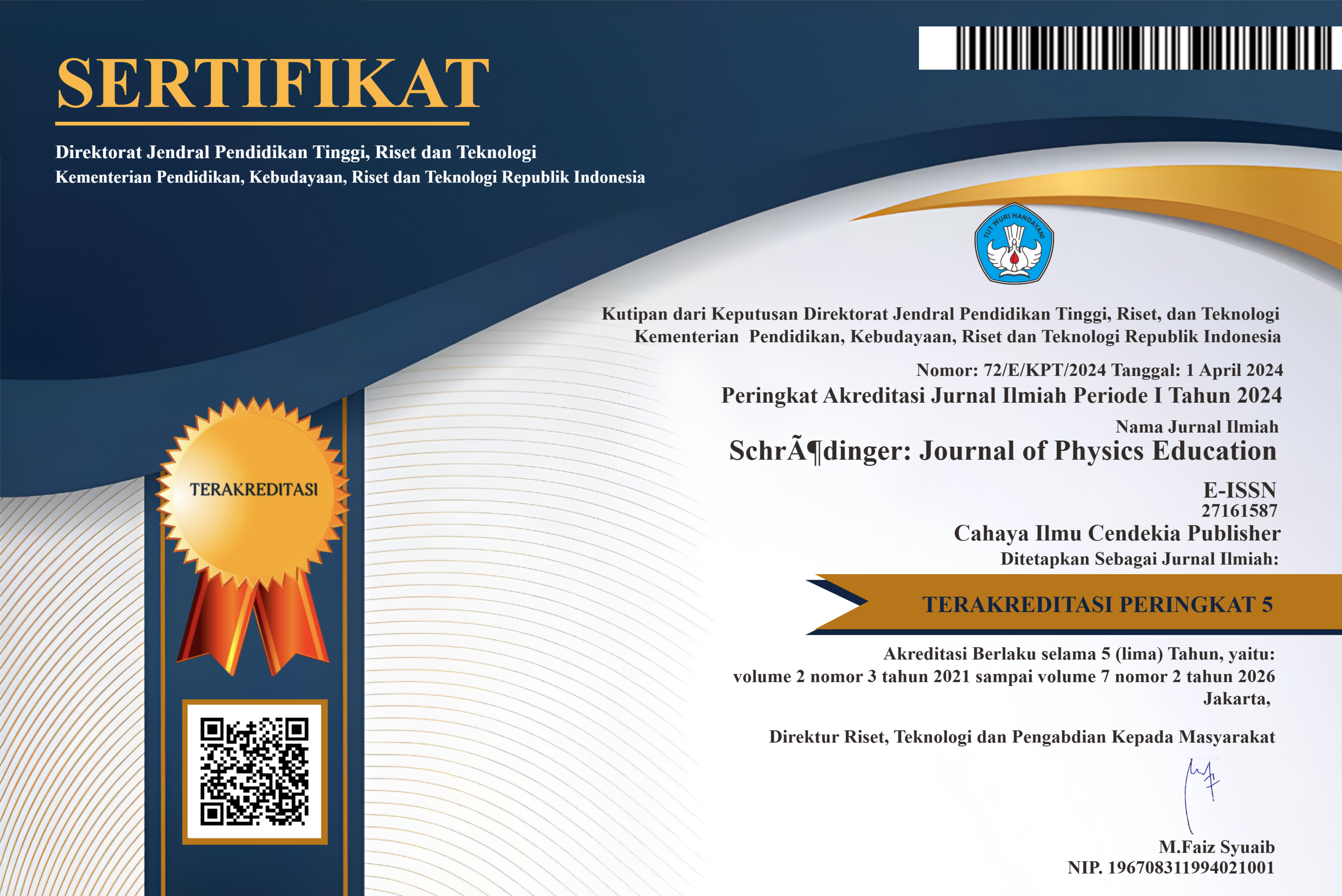Exploring Innovative Approaches: Optimizing Google Classroom for Enhanced Motivation in Science Learning
Abstract
Purpose of the study: This research aims to investigate the challenges encountered in utilizing Google Classroom as a learning platform and its implications for motivating students in studying science, with a focus on identifying both internal and external factors affecting students' engagement and interest in the subject.
Methodology: This study employs a descriptive qualitative approach to explore the challenges associated with using Google Classroom as a learning tool for motivating science study. Data collection methods include observation, questionnaires, interviews, and documentation. The analysis involves data reduction, presentation (Data Display), and conclusion drawing/verification stages. Data validity is ensured through triangulation of data sources, enhancing the reliability of the findings.
Main Findings: The research highlights internal problems like difficulty with Google Classroom, limited smartphone access (1.03%), material comprehension issues, and insufficient teacher explanations. External challenges include lack of family support and teacher interaction. Solutions include providing internet data for infrastructure issues, motivational videos on Google Classroom, video-based learning, and student self-initiated learning via Google, YouTube, and books. Student motivation for science learning through Google Classroom is moderate at 56%.
Novelty/Originality of this study: This research contributes novelty by scrutinizing the nexus between Google Classroom and student motivation in science education, addressing a significant gap in current literature. By elucidating nuanced challenges and implications for student engagement, the study offers fresh insights into optimizing digital learning platforms to enhance motivation and learning outcomes in science education amidst the evolving educational landscape shaped by technology.
References
D. R. Retnani, R. Royani, C. Beccles, and A. Afras, “Improving Science Learning Outcomes on Light and Optical Instruments Through Visual Methods in Junior High Schools,” Schrödinger J. Phys. Educ., vol. 5, no. 1, pp. 32–38, 2024, doi: 10.37251/sjpe.v5i1.883.
Kamid et al., “Comparison and Effect of Persistent Character and Mathematical Process Skills on Fractional Computing Operation Materials in Elementary School,” J. Innov. Educ. Cult. Res., vol. 4, no. 3, pp. 438–449, 2023, doi: 10.46843/jiecr.v4i3.475.
K. M. Stanney, A. Skinner, and C. Hughes, “Exercisable Learning-Theory and Evidence-Based Andragogy for Training Effectiveness using XR (ELEVATE-XR): Elevating the ROI of Immersive Technologies,” Int. J. Hum. Comput. Interact., vol. 39, no. 11, pp. 2177–2198, 2023, doi: 10.1080/10447318.2023.2188529.
M. R. Matthews, Thomas Kuhn and Science Education: Learning from the Past and the Importance of History and Philosophy of Science, no. 0123456789. Springer Netherlands, 2022. doi: 10.1007/s11191-022-00408-1.
I. P. Canlas and M. Karpudewan, “Blending the Principles of Participatory Action Research Approach and Elements of Grounded Theory in a Disaster Risk Reduction Education Case Study,” Int. J. Qual. Methods, vol. 19, pp. 1–13, 2020, doi: 10.1177/1609406920958964.
M. Maison, D. A. Kurniawan, R. P. Wirayuda, and D. Chen, “Process Skills-Based E-Module: Impact On Analytical Thinking Skills,” J. Penelit. Pengemb. Pendidik. Fis., vol. 8, no. 1, pp. 23–34, 2022, doi: 10.21009/1.08103.
F. N. Istiadah, Teori-teori belajar dalam pendidikan. Tasikmalaya: Edu Publisher, 2020.
F. R. Winda and M. Shofiardin, “Describing the Ability of Science Processes in Basic Physics Practicum II Material of Ice Melting Heat Using E-Modules,” SchrödingerJournal Phys. Educ., vol. 4, no. 1, pp. 18–23, 2023, doi: 10.37251/sjpe.v4i1.492.
A. Mawardani, M. Mirunalini, C. Meechi, and S. Shah, “Development of Interactive Multimedia Based on Adobe Flash as a Learning Media Steps of Geographical Research,” vol. 1, no. 1, pp. 16–24, 2023, doi: 10.37251/jetlc.v1i1.620.
R. Katawazai, “Implementing outcome-based education and student-centered learning in Afghan public universities: the current practices and challenges,” Heliyon, vol. 7, no. 5, p. e07076, 2021, doi: 10.1016/j.heliyon.2021.e07076.
S. S. Cahyati, T. Tukiyo, N. Saputra, J. Julyanthry, and H. Herman, “How to Improve the Quality of Learning for Early Childhood? An Implementation of Education Management in the Industrial Revolution Era 4.0,” J. Obs. J. Pendidik. Anak Usia Dini, vol. 6, no. 5, pp. 5437–5446, 2022, doi: 10.31004/obsesi.v6i5.2979.
V. Hong Van, “Identify Methods of Teaching and Learning To Create Interest, Self-Study, and Creativity of Students,” Humanit. Soc. Sci. Rev., vol. 8, no. 3, pp. 646–656, 2020, doi: 10.18510/hssr.2020.8369.
L. T. Hang and V. H. Van, “Building strong teaching and learning strategies through teaching innovations and learners’ creativity: A study of vietnam universities,” Int. J. Educ. Pract., vol. 8, no. 3, pp. 498–510, 2020, doi: 10.18488/journal.61.2020.83.498.510.
B. R. Wilcox and H. J. Lewandowski, “A summary of research-based assessment of students’ beliefs about the nature of experimental physics,” Am. J. Phys., vol. 86, no. 3, pp. 212–219, 2018, doi: 10.1119/1.5009241.
A. De Guzman, J. Mi. Bayot, N. Javier, R. R. Liamzon, and M. A. R. Moralejo, “Understanding Filipino hospitality interns’ expectations and frustrations,” Anatolia, vol. 31, no. 3, pp. 479–493, 2020, doi: 10.1080/13032917.2020.1771601.
M. A. Pisnaji, A. A. Putri, and H. Ramadani, “Mengindentifikasi Sikap dan Karakter Toleransi Siswa Sekolah Menengah Atas,” Schrödinger J. Phys. Educ., vol. 1, no. 4, pp. 107–111, 2020, doi: 10.37251/sjpe.v1i4.445.
S. Clivaz and T. Miyakawa, “The effects of culture on mathematics lessons: an international comparative study of a collaboratively designed lesson,” Educ. Stud. Math., vol. 105, no. 1, pp. 53–70, 2020, doi: 10.1007/s10649-020-09980-1.
Y. Ariyana, A. Pudjiastuti, R. Bestary, and Zamroni, Learning Oriented Handbook on Higher Order Thinking Skills. Jakara: Ministry of Education and Culture, 2018.
P. Zhang and S. Li, “Associative cultural landscape approach to interpreting traditional ecological wisdom: A case of Inuit habitat,” Front. Archit. Res., vol. 13, no. 1, pp. 79–96, 2023, doi: 10.1016/j.foar.2023.09.008.
A. Abulibdeh, E. Zaidan, and R. Abulibdeh, “Navigating the confluence of artificial intelligence and education for sustainable development in the era of industry 4.0: Challenges, opportunities, and ethical dimensions,” J. Clean. Prod., vol. 437, no. January, p. 140527, 2024, doi: 10.1016/j.jclepro.2023.140527.
K. Iordanou and C. Rapanta, “‘Argue With Me’: A Method for Developing Argument Skills,” Front. Psychol., vol. 12, no. March, 2021, doi: 10.3389/fpsyg.2021.631203.
A. Almonacid-Fierro, R. Vargas-Vitoria, R. S. De Carvalho, and M. A. Fierro, “Impact on teaching in times of COVID-19 pandemic: A qualitative study,” Int. J. Eval. Res. Educ., vol. 10, no. 2, pp. 432–440, 2021, doi: 10.11591/ijere.v10i2.21129.
N. V. Telegina, S. E. Drovosekov, D. G. Vasbieva, and V. L. Zakharova, “The use of project activity in teaching mathematics,” Eurasia J. Math. Sci. Technol. Educ., vol. 15, no. 8, 2019, doi: 10.29333/ejmste/108439.
A. L. Abbott, “Fostering student interest development: An engagement intervention,” Middle Sch. J., vol. 48, no. 3, pp. 34–45, 2017, doi: 10.1080/00940771.2017.1297666.
L. S. Keiler, “Teachers’ roles and identities in student-centered classrooms,” Int. J. STEM Educ., vol. 5, no. 1, 2018, doi: 10.1186/s40594-018-0131-6.
V. U. Pratiwi, Andayani, R. Winarni, and A. Anindyarini, “Digital Storybook to Transform Character Education of Local Wisdom Figures for Elementary School Students,” J. Soc. Stud. Educ. Res., vol. 13, no. 4, pp. 250–264, 2022, [Online]. Available: https://jsser.org/index.php/jsser/article/view/4670
L. Hasibuan and A. Nugraha, “Development of Scientific and Constructivism-Based Handouts on Social Arithmetic Materials,” Indones. J. Educ. Res., vol. 4, no. 2, pp. 28–31, 2023, doi: 10.37251/ijoer.v4i2.578.
C. P. Arlinda, A. Marianti, and M. Rahayuningsih, “The Implementation of Project-Based Learning Model with Instagram Media towards Students’ Critical Thiking and Creativity,” Unnes Sci. Educ. J., vol. 11, no. 1, pp. 9–16, 2022, doi: 10.15294/usej.v11i1.46495.
M. Muhammad, “Promoting students’ learning motivation through project-based learning using Muvizu in 21st-century education,” Cypriot J. Educ. Sci., vol. 15, no. 5, pp. 899–908, 2020, doi: 10.18844/CJES.V15I5.5120.
F. A. Perdana, S. H. Zakariah, T. Alasmari, and R. Pasca, “Development of Learning Media in the Form of Electronic Books with Dynamic Electricity Teaching Materials,” vol. 1, no. 1, pp. 1–6, 2023, doi: 10.37251/jetlc.v1i1.619.
I. D. Ivanov, “The Use of Interactive Student Response Software in an Introductory International Relations Course,” J. Polit. Sci. Educ., vol. 0, no. 0, pp. 1–18, 2019, doi: 10.1080/15512169.2019.1694533.
S. S. S. Hassan, “Measuring attitude towards learning science in Malaysian secondary school context: implications for teaching,” Int. J. Sci. Educ., vol. 40, no. 16, pp. 2044–2059, 2018, doi: 10.1080/09500693.2018.1518614.
M. Banafaa et al., “6G Mobile Communication Technology: Requirements, Targets, Applications, Challenges, Advantages, and Opportunities,” Alexandria Eng. J., vol. 64, pp. 245–274, 2023, doi: 10.1016/j.aej.2022.08.017.
J. C. T. Bieser and L. M. Hilty, “Conceptualizing the impact of information and communication technology on individual time and energy use,” Telemat. Informatics, vol. 49, pp. 1–16, 2020, doi: 10.1016/j.tele.2020.101375.
J. P. Zwolak, R. Dou, E. A. Williams, and E. Brewe, “Students’ network integration as a predictor of persistence in introductory physics courses,” Phys. Rev. Phys. Educ. Res., vol. 13, no. 1, pp. 1–14, 2017, doi: 10.1103/PhysRevPhysEducRes.13.010113.
A. Aldiab, H. Chowdhury, A. Kootsookos, F. Alam, and H. Allhibi, “Utilization of Learning Management Systems (LMSs) in higher education system: A case review for Saudi Arabia,” Energy Procedia, vol. 160, no. 2018, pp. 731–737, 2019, doi: 10.1016/j.egypro.2019.02.186.
R. Johnson, “Enhancing Classroom Communication and Collaboration: The Effectiveness of Google Classroom,” J. Educ. Technol., vol. 42, no. 4, pp. 367–382, 2018, doi: 10.1080/15391523.2018.1234567.
A. Khan, “The Role of E-Learning Technologies in Sustaining Education During Crisis: A Case Study of Google Classroom,” Int. J. Distance Educ. Technol., vol. 18, no. 3, pp. 58–72, 2020, doi: 10.4018/IJDET.2020070103.
R. Handayani and D. Wulandari, “Modern Assessment dalam Menyongsong Pembelajaran Abad 21 dan Hambatan di Negara Berkembang,” J. Pendidik. Edutama, vol. 8, no. 1, p. 13, 2021, doi: 10.30734/jpe.v8i1.1363.
I. Asakir and F. Mahmudah, “Kreativitas dan Inisiatif Guru dalam Pengembanggan Mutu Pembelajaran Online,” J. Stud. Guru dan Pembelajaran, vol. 5, no. 1, pp. 31–40, 2022, doi: 10.30605/jsgp.5.1.2022.1541.
M. H. Hariadi, J. Jumadi, I. Wilujeng, H. Kuswanto, W. Wulandari, and S. Sundari, “Inquiry Training Learning Model Assisted by Google Classroom to Improve Creative Thinking Skills of Senior High School Students,” JPI (Jurnal Pendidik. Indones., vol. 8, no. 2, p. 198, 2019, doi: 10.23887/jpi-undiksha.v8i2.17339.
N. Ainiyah et al., “Influence of Self-Motivation and Health Locus of Control on Adherence to Medication Among Hypertension Patients,” J. Keperawatan Indones., vol. 26, no. 1, pp. 11–19, 2023, doi: 10.7454/jki.v26i1.2526.
T. Nygård, N. Hirvonen, S. Räisänen, and R. L. Korkeamäki, “Ask Your Mother! Teachers’ Informational Authority Roles in Information-seeking and Evaluation Tasks in Health Education Lessons,” Scand. J. Educ. Res., vol. 0, no. 0, pp. 1–14, 2020, doi: 10.1080/00313831.2020.1788145.
M. T. Machmud, A. P. Widiyan, and N. R. Ramadhani, “The development and policies of ICT supporting educational technology in Singapore, Thailand, Indonesia, and Myanmar,” Int. J. Eval. Res. Educ., vol. 10, no. 1, pp. 78–85, 2021, doi: 10.11591/ijere.v10i1.20786.
R. R. F. Sinaga and R. Pustika, “Exploring Students’ Attitude Towards English Online Learning Using Moodle During Covid-19 Pandemic At Smk Yadika Bandarlampung,” J. English Lang. Teach. Learn., vol. 2, no. 1, pp. 8–15, 2021, doi: https://doi.org/10.33365/jeltl.v2i1.850.
T. Harrison, “Open Learning : The Journal of Open , Distance and e- How distance education students perceive the impact of teaching videos on their learning,” Open Learn. J. Open, Distance e-Learning, vol. 00, no. 00, pp. 1–17, 2022, doi: 10.1080/02680513.2019.1702518.
M. K. Afıfy, “Effect of interactive video length within e-learning environments on cognitive load, cognitive achievement and retention of learning,” Turkish Online J. Distance Educ., vol. 21, no. 4, pp. 68–89, 2020.
Copyright (c) 2024 Emmanuel Pujono, Farid Maulana, Travis W Arment, Nino Sozashvili

This work is licensed under a Creative Commons Attribution 4.0 International License.
Authors who publish with this journal agree to the following terms:
- Authors retain copyright and acknowledge that the Schrödinger: Journal of Physics Education is the first publisher licensed under a Creative Commons Attribution 4.0 International License.
- Authors are able to enter into separate, additional contractual arrangements for the non-exclusive distribution of the journal's published version of the work (e.g., post it to an institutional repository or publish it in a book), with an acknowledgment of its initial publication in this journal.
- Authors are permitted and encouraged to post their work online (e.g., in institutional repositories or on their website) prior to and during the submission process, as it can lead to productive exchanges and earlier and greater citation of published work.







.png)
.png)








.png)
.png)
.png)







